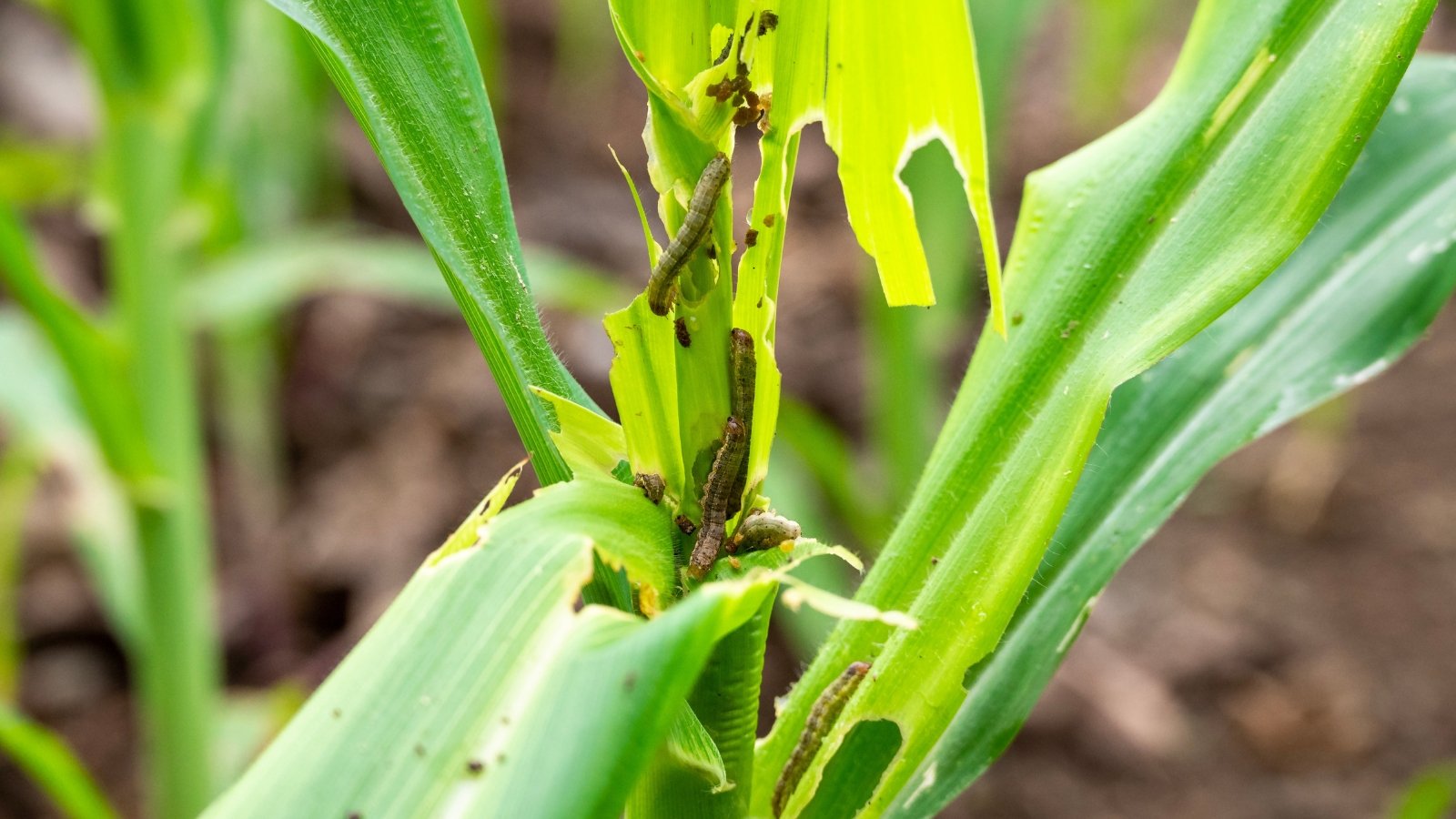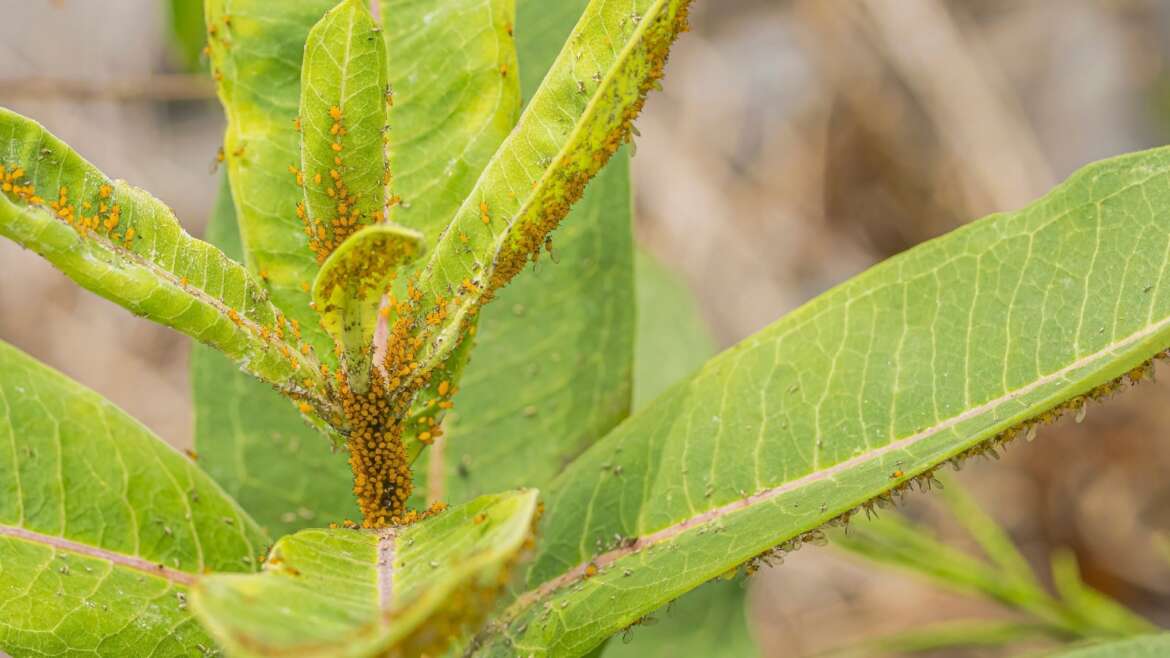Fall is one of my favorite times to be in the garden. The cooler days and crisper air are a welcome relief after hot, humid summers and make tasks feel less urgent. Plus, fall vegetables like cauliflower, broccoli, and rutabagas offer abundant, chill-sweetened harvests.
However, fall gardens are rarely perfect. Even though the cooler temperatures and shorter days lead to a decrease in pest pressure, a handful of pests still stick around. If you take on too much of a laissez-faire approach, cabbage worms and aphids may quickly devour your otherwise perfect crops. Trust me, I’ve been there.
Knowing some common fall vegetable pests will help you differentiate the good guys from the bad bugs. I’ll share some noteworthy pests and explain helpful control methods.
Aphids
Act quickly against these pests to prevent rapid population growth.
If you’ve grown plants for more than a few months, you’re probably familiar with aphids. These small, soft-bodied pests attack a wide range of plants, from tropical houseplants to tall trees to hardy vegetables. There are many different aphid species, but all of them have similar appearances and feeding methods.
Aphids have small straw-like mouthparts they use to pierce plant leaves and then drink the sap. Although a few aphids won’t cause any noticeable damage, these vegetable pests can quickly multiply in any season, including fall. An aphid can go from a newborn nymph to an adult in under a week, and each female aphid can produce over 50 nymphs per week. That means ten aphids can grow to over a million in about six weeks!
While aphids reproduce and mature slower in the fall than they do in the summer, small populations can still grow quickly. And these larger populations can severely weaken a wide variety of vegetable plants. Therefore, you should get aphids under control as soon as you spot them.
Control Options
Although aphids are prevalent in the garden, many natural predators feed on them. Maintaining a diverse habitat and avoiding broad-spectrum pesticides will encourage the presence of beneficial insects like ladybugs, green lacewings, and parasitic wasps. These predators can seek out aphids and eat them before they have time to balloon into a big problem.
Even if you try to maintain a healthy ecosystem, aphids may still become a problem worth treating. If you notice a dozen or so of the pests on your plants, you can wipe them off with a wet, soapy rag. You can also attempt to wash them off your plants with a powerful spray of the hose.
Larger outbreaks often require more intensive methods. Spraying the soft-bodied pests with neem oil, insecticidal soap, or another type of horticultural oil will kill them. Ensure the spray contacts the pests for the best results. Spray outside peak pollinator activity in the early morning or at dusk. A light mist is enough.
Harlequin Bugs
 Despite their beauty, these bugs can severely damage plants.
Despite their beauty, these bugs can severely damage plants.
Harlequin bugs may look beautiful, but don’t let their intricate red, black, and white patterns fool you. These pests can cause serious damage!
During the fall, you’re most likely to spot the adult form of the pest on your vegetables. They’re about half an inch long with shield-shaped bodies similar to stink bugs. In warmer areas, you may continue to see the black and white striped eggs and small black and red nymphs throughout the fall.
These true bugs attack members of the Brassicae family, such as kale, cabbage, cauliflower, and broccoli. They use their piercing/sucking mouthparts to drink up plant sap, and their feeding leads to yellow or brown spots on leaves. When harlequin bugs appear in large numbers, they can severely weaken or even kill plants. Therefore, it’s best to get them under control as soon as you see them appear.
Control Options
If you spot a handful of adults hanging around your cabbage plants or munching on your turnip greens, use your fingers to squash them. This can be a messy job, but wearing gloves makes it more manageable. You can also pick the bugs off and place them in a container filled with soapy water. The same goes for any egg masses you may find.
You can treat larger infestations with organic insecticides like neem oil and insecticidal soap. Since the bugs typically lay their eggs on the undersides of leaves, make sure to spray all sides of the foliage. You may need to make repeated applications to fully eradicate them.
Armyworms
 These caterpillar pests can quickly devastate your fall vegetable garden.
These caterpillar pests can quickly devastate your fall vegetable garden.
Multiple species of armyworms can become pests in the fall veggie garden. These include the fall armyworm, beet armyworm, and southern armyworm. All types of armyworms are juvenile forms of moths.
The juveniles are caterpillars that vary in appearance depending on the species, age of larvae, and individual. The larvae emerge less than a quarter of an inch long and grow to a little over an inch. They may be green, gray, black, brown, or some combination of these colors.
Armyworms get their name from their tendency to travel in groups when looking for new food sources. Therefore, large numbers of pests can appear at once.
The affected plants vary depending on the armyworm species. Some veggies impacted include beets, broccoli, lettuce, and cabbage. Although you can often spot the pests themselves, you may also notice irregularly shaped holes in the leaves.
Control Options
One way to treat armyworms is to physically remove them from the plants. However, this is often difficult if the caterpillars are very small or present in large numbers.
Another control option includes spraying the affected crops with a naturally occurring soil bacteria called Bacillus thuringiensis (Bt). As the armyworms eat the Bt, they stop feeding and eventually die. Although Bt harms these caterpillars, it won’t impact beneficial insects like parasitic wasps, green lacewings, and hoverflies. It will impact other caterpillars, though.
Cabbage Worms
 These pests create ragged holes in brassica crops’ leaves.
These pests create ragged holes in brassica crops’ leaves.
Cabbage worms are common fall pests that attack a variety of brassica-family vegetables. Some of their favorite plants include cabbage, turnips, broccoli, cauliflower, kale, collards, and bok choy. They chew on the leaves, leading to ragged holes and possibly defoliated plants.
The caterpillars vary in appearance depending on the species. Imported cabbage worms are light green. Cross-striped cabbage worms have light blue and black striped backs and large yellow and black stripes across the sides of their bodies.
Both of the species mature into moths that lay their eggs on the undersides of leaves. The imported cabbageworm lays single, light yellow oblong eggs, while the cross-striped worm lays clusters of flat, yellow eggs.
Control Options
The best way to control cabbage worms depends on the number of worms on your plants. If you spot a handful of worms and eggs, you can remove them by hand. However, be aware the adults will continue to lay eggs on your plants.
If you have a large infestation and lots of tiny caterpillars, you can spray the plants with Bt. This bacteria enters into the digestive tracts of members of the Lepidoptera family and stops them from feeding. It will not harm other insects, but you should always follow application instructions when using it.
Cabbage Loopers
 These slender caterpillars chew irregular holes in brassica leaves.
These slender caterpillars chew irregular holes in brassica leaves.
Although some gardeners often confuse them with cabbage worms, cabbage loopers are an entirely different pest. They are more slender than other similar pests and move like an inchworm. They’re also always light green, with faint white stripes down their sides.
These pests feed on numerous fall brassica-family vegetables, including cabbage, kale, broccoli, cauliflower, and collards. Although they’re present throughout much of the growing season, you’ll often notice a serious increase in activity in the fall.
When the larvae are young, they feed on the undersides of leaves. Therefore, you may not notice they’re there when they first appear. As they grow older, they chew through the entire leaf, causing irregular holes. If left untreated, they can defoliate entire leaves.
Along with looking out for the larvae, you can also keep an eye out for the eggs and adults. The adults are small brown moths known as owlet moths. These moths lay single light yellow eggs on brassica leaves.
Control Options
One way to control cabbage loopers is to remove the eggs and larvae by hand. You can either crush them in your fingers or place them in a bucket filled with soapy water.
Another option is to spray the infected plants with Bt. This is a naturally occurring soil bacteria that harms the digestive tracts of moth and butterfly larvae. When the cabbage loopers ingest the bacteria, they stop feeding and die. Since Bt washes off in the rain, you will likely need to spray your plants once every week.
You can also exclude cabbage loopers from your plant with row cover. Just make sure there aren’t any eggs or larvae on your plants before you cover them!
Flea Beetles
 Tiny beetles cause ‘shothole’ damage to leafy brassicas.
Tiny beetles cause ‘shothole’ damage to leafy brassicas.
Although they’re small, flea beetles can quickly decimate leafy brassicas like arugula, radish greens, kale, collards, and bok choy. Some species also eat crops like spinach, peppers, and eggplant. These pests are often a larger problem in warm weather but remain in the garden into the fall.
There are multiple flea beetle species, but all of them look similar. They have oblong bodies that are black, bronze, or gray and slender legs they use to jump short distances. Most species are less than a quarter of an inch long. Despite their small size, they can eat a lot in a day, leaving small ‘shothole’ damage in the leaves.
Flea beetles aren’t likely to kill plants, but they lead to ugly leaves. Over time, plants can become stunted and weak due to the damage.
Control Options
One of the best ways to prevent flea beetle damage is to physically exclude the tiny bugs from your crops. You can lay a piece of row cover or insect netting over your plants and secure the edges to the ground with sandbags or other heavy objects. Just make sure there aren’t any pests on your plants before you cover them, or you’ll just be trapping them in.
You can also spray the pests with organic insecticides. Some effective options include pyrethrins and spinosad. If you choose to use chemical controls, make sure to carefully follow product instructions.
Cutworms
 Larvae cut through plant stems, causing seedlings to topple.
Larvae cut through plant stems, causing seedlings to topple.
Cutworm is the generic name for moth larvae that feed on young plant stems. The larvae cut all the way through the stem, causing the seedlings to fall to the ground. Since cutworms eat small stems, seedlings are the most susceptible to damage. The pests feed on a variety of crops, including cabbage, kale, collards, beans, peppers, and lettuce.
Although the different species vary in appearance, they share some similarities. The larvae are plump, hairless, and some variation of brown, black, and gray. They often curl up into a C-shape when touched.
The worms often hide in debris during the day and feed at night. Therefore, it can be difficult to spot them. However, digging near the bases of the infected plants will often reveal the pests.
Control Options
Since cutworms hide under soil debris, avoid mulching near the base of recently transplanted seedlings. You can add mulch once the seedlings are larger. You should also keep your garden weed-free and remove any plant debris that falls on the ground.
Since the cutworms eat through entire stems, spraying plants with insecticides isn’t effective. However, you can physically protect tender seedlings by placing a cardboard or aluminum foil collar around the base of the stem. Place an inch or two of the material under the soil and leave another two inches above the ground.




